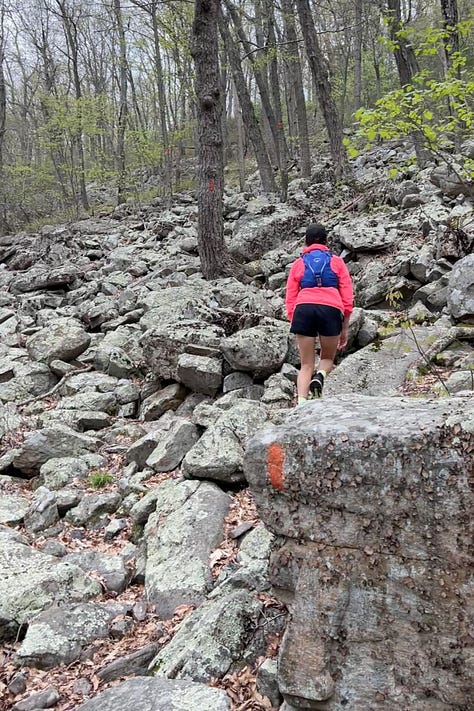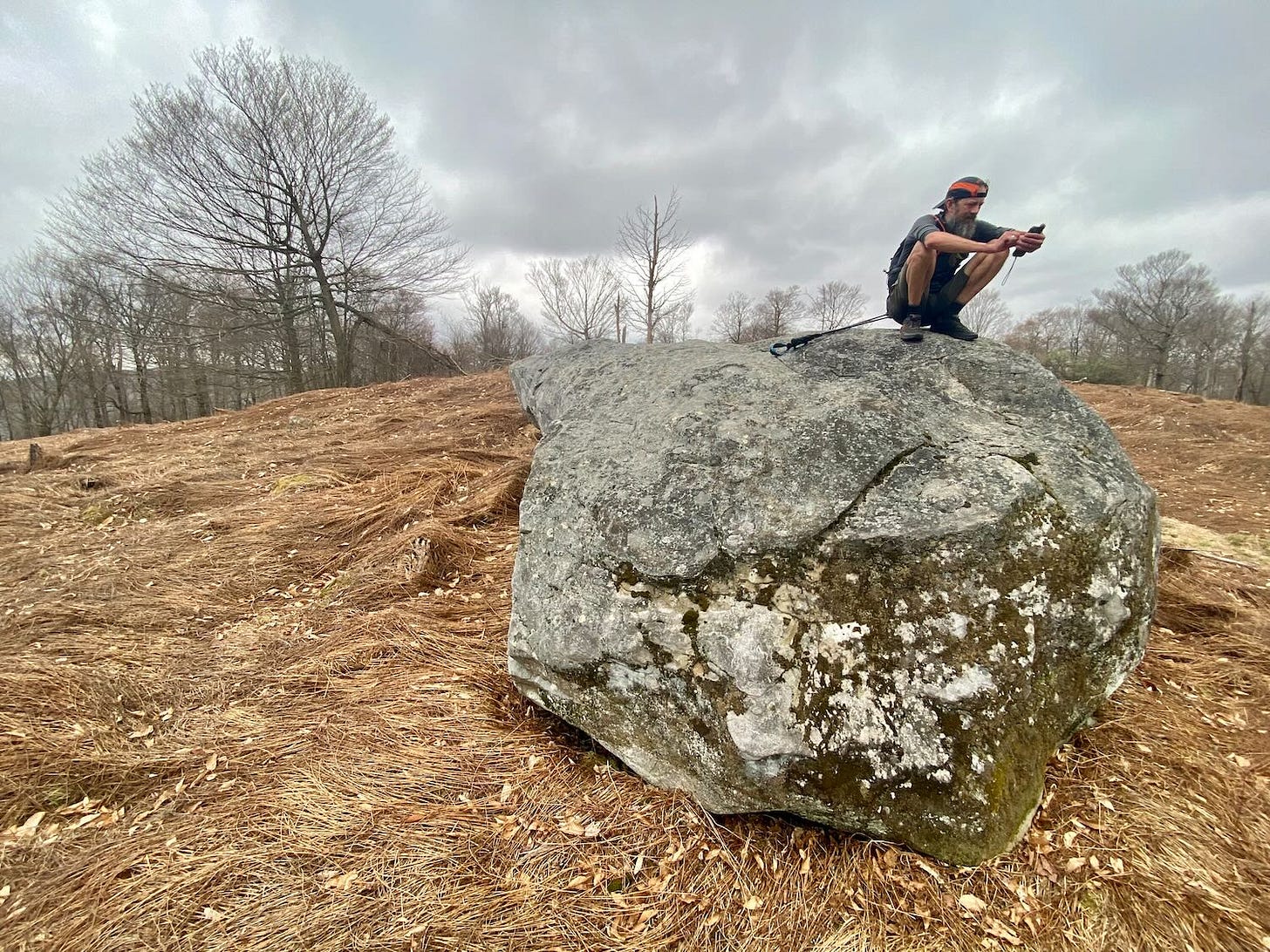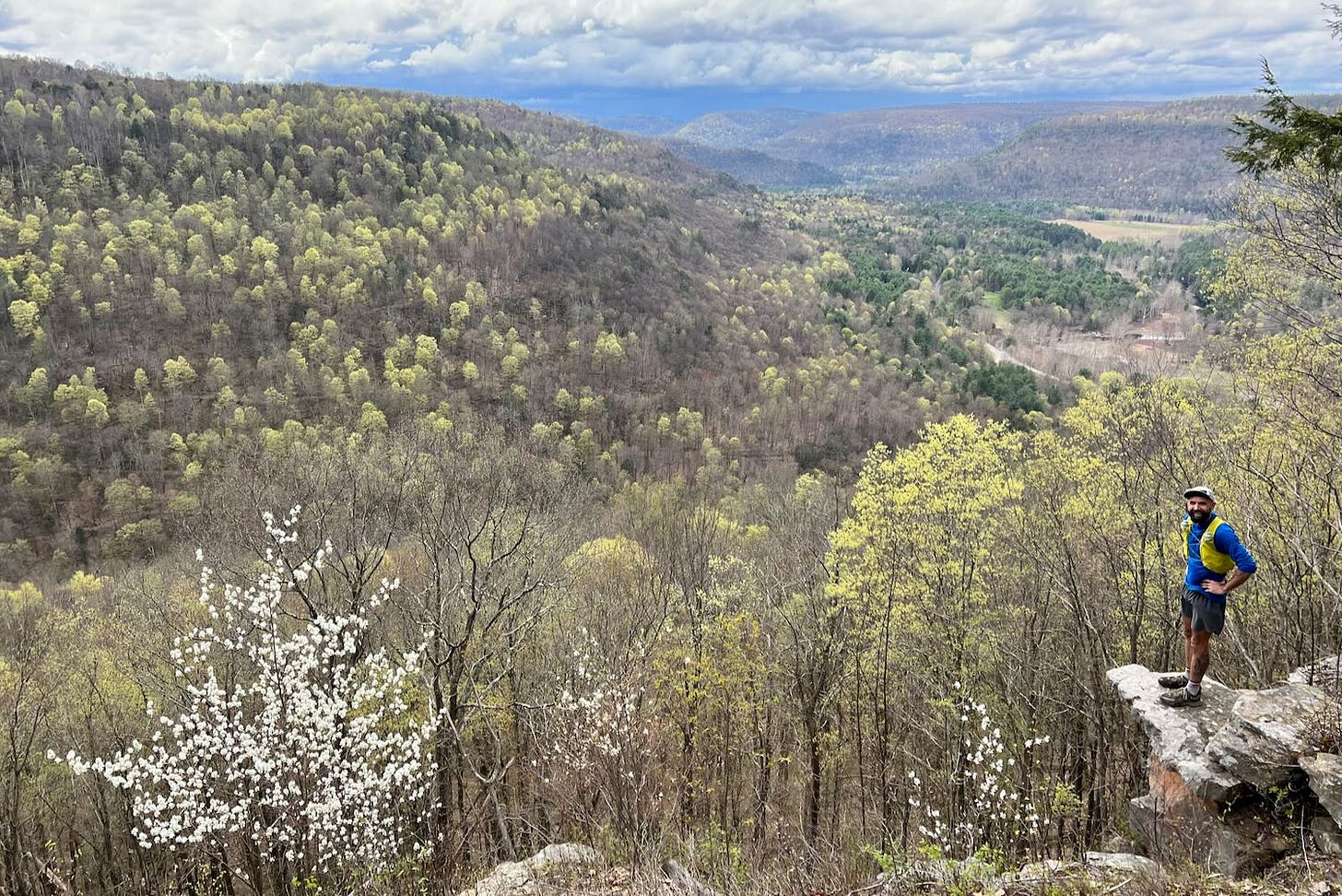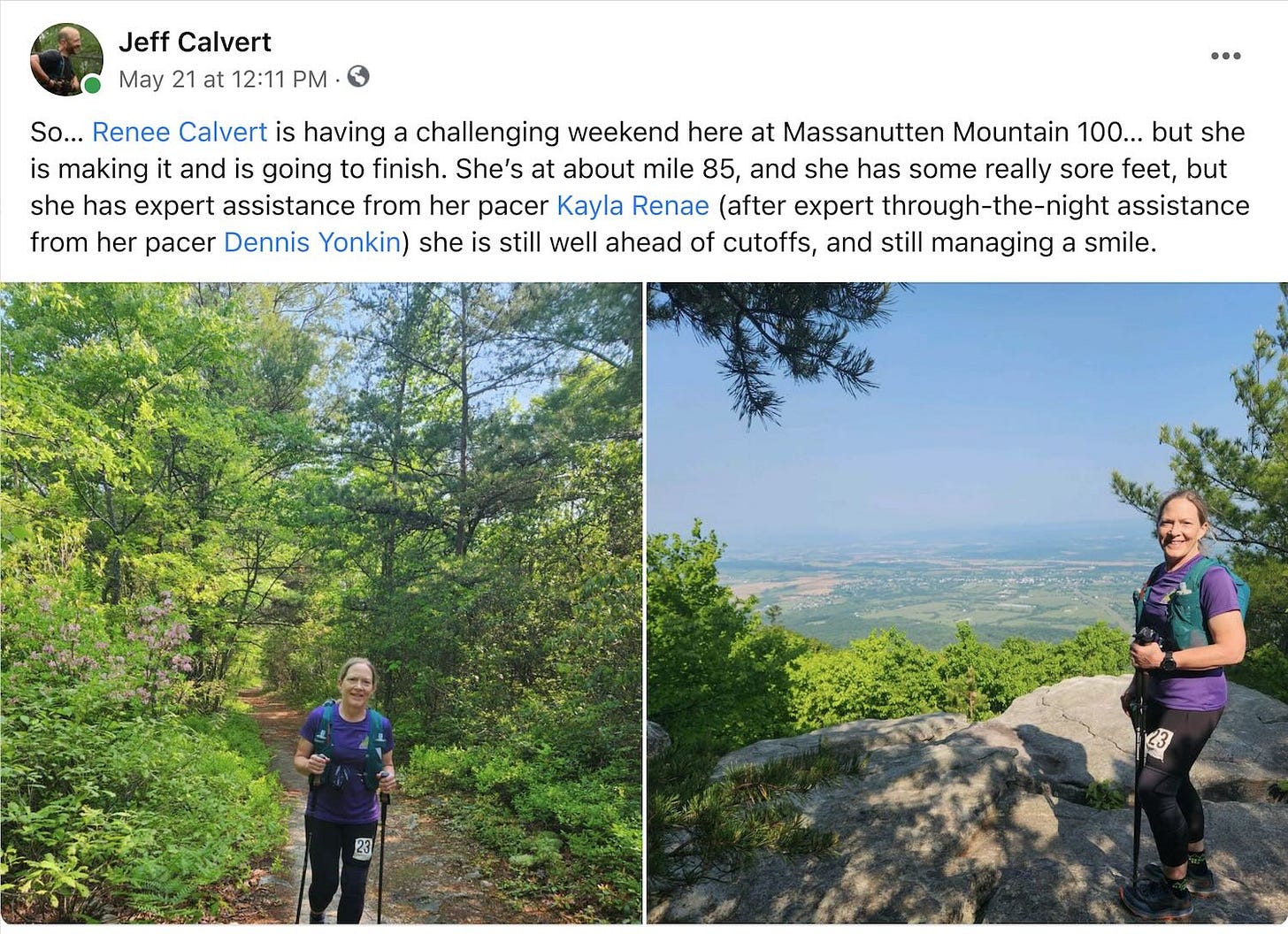Train-up (Western States part 3)
Serious training to a peak (shut up and run)
This is the third installment in a series about my upcoming Western States Endurance Run adventure. My intent is to give you a look behind the curtain, to maybe demystify this ultra thing, and show how fairly normal people go about doing big things. We each have our own approach, but I imagine every successful ultrarunner uses some version of a process something like this one. I also imagine there might be some lessons from this process that apply to other big endeavors — maybe even one of yours…
The Train-up
The fallow was largely philosophical. Not so the train-up. This phase is all physiology, all about pushing hard to get strong. In short, it’s time to shut up and run.
But not without a plan…
Begin with the end in mind
I have goals for this race (a finish, a 100-mile PR, a sub-24-hour finish) but those aren’t particularly helpful for building a training plan. So let’s restate: to go sub-24, I need to cut 27 minutes from my prior best. I need to be 16 or 17 seconds faster in an average mile, drop my average pace from 14 minutes and 40 seconds per mile, down to 14:24.
That’s a small change on the margin (less than 2%). It does not demand radical reinvention of my training approach, it calls for marginal improvement — a bit more focus, a bit more work. So I will base this train-up on my best prior train-ups, and I’ll improve upon them by increasing both consistency and volume.
In broad terms, this means a 14 or 15-week train-up, starting at my 50-mile/5,000-foot base week and building steadily to a peak of 70+ miles per week, then a 2 or 3-week taper with reduced volume before the race.
More specifically…
Volume targets
Volume is not everything, but it’s a lot (especially for long ultras). It’s easy to measure, it’s objective, and it yields the most reliable gains in both fitness and confidence. It also makes for a good game — look at the old numbers (from prior train-ups) and beat them.
Of course there’s a caveat to that… as volume goes up, the potential for injury grows and the potential benefits get smaller. For me, pushing much beyond 70 miles per week (or doing individual runs much longer than a marathon) takes me to a risk/reward line I’ve learned I don’t want to cross.
With that in mind, beyond just staying ahead of prior years, I have some specific targets:
At least 4 miles every day, with a proper warm-up and stretching routine before every run.
At least 50 miles every week, with at least 5,000 feet of ascent.
At least 3 weeks with over 70 total miles.
At least 3 weeks with over 10,000 total feet of ascent.
At least 3 weeks with back-to-back runs that total 30 miles or more.
At least 3 runs longer than 20 miles.
At least 3 runs with more than 4,000 feet of ascent.
Other considerations
Again, volume isn’t everything. Here are some of the other things I want to pay attention to:
Intensity. I want almost all of my training to be aerobic (below my metabolic efficiency point — the crossover point where my body is getting more fuel from carbs than fat)1. I use a heart rate monitor as an electronic conscience to enforce that speed limit, and help me get the most from my training.
Specificity. Western States is notorious for the kind of long, runnable descents that are hard on the quadriceps. It’s hard to find trails like that in PA (ours are generally too rocky to go fast enough to get the same effect), but our forest roads are a reasonable match, and that’s what I focused on. My standard long-run pattern was a steep, rocky climb, straight up a fall-line trail, and then a pounding descent on forest roads — over and over.
Heat adaptation. Western States is also known for potentially high temperatures (sometimes over 110F), and I see this as the main wildcard I face there. My plan is to gain some initial adaptation during the train-up by seeking out the heat when we get it, but I’ll mainly rely on an intensive heat training program during the taper.
Fat adaptation. I’ve been working on this for several years now, and I’m pretty solid with it, able to perform well on about 100 carb calories (one gel) per hour during a race. But to keep that edge, I did a fairly strict 4-week ketogenic reset early in the train-up, and I regularly do fasted long runs.
Physical competence. Those non-running things like flexibility, proprioception, and strength contribute directly to running performance, but they are harder to measure, and easy to neglect. Good intentions are not enough —I have to actually do the drills. The more consistent I am with this, the fewer injuries I’ll have and the stronger, better runner I will be.
Related to this, a Western States quirk… for whatever reason, they don’t allow trekking poles. I’ve come to rely on poles, not for propulsion, but to keep myself from falling when I become stumbly. So weaning myself from them is a priority (and those smooth western trails are no consolation — easy trails are where I seem to fall the most).
What about speed work? Well, maybe, if I’m meeting or exceeding the other targets and still feel mechanically sound. But cautiously, in small doses, never more than once per week. My goal for speed work is not speed per se, but to improve baseline cruising speed, the pace I naturally settle into and can comfortably maintain for hours. There is no scenario where having a faster finishing kick is anything but performative for me (if I can manage anything more than a steady finish, I should have rationed out that extra energy over the final 30 miles instead). But shaving seconds off that baseline pace could shave minutes off the finish time.
So, how did it go?
It went well.
From the standpoint of volume and consistency, I beat my best prior train-ups by more than 130 miles and 21,000 feet of ascent, and I met my volume targets. Here’s the chart:

So, the numbers look good, but it’s always good to validate ground truth with a benchmark run. For this, I used a trail-proofing assignment at the Worlds End 100k, a 22-mile run with about 4,400 feet of ascent that I’ve done on the same day the past two years. The results were good: with similar conditions, I was 30 minutes faster than my prior best, with an average heart rate 10 bpm lower.
It’s not definitive, but I’ll take it as a good sign.
And I’ll head into the taper feeling satisfied with the train-up, and optimistic about this race.
Some Highlights from the Train-up
Most of my miles were solo, and I like it that way. But every so often, it’s nice to have company — it can make a long run feel both shorter and more significant.
This time I got out with Mary on the Mid State Trail, Kayla on the Standing Stone Trail…



…and Leon on the Loyalsock Trail (his first visit to Worlds End(!))
And for pre-race inspiration (and a reminder of what is possible), could there have been anything better than crewing for Renee at Massanutten 100, and being part of her heroic performance there?
It sets a tone…
By the way… I’m officially in (!)
The poetic nature of my experience with this race continues…
I knew it would come (my invitation to move from the wait list into the race), but I didn’t think it would come so soon. I was waiting for Renee at a Massanutten aid station (one of the few with a cell signal), when I got it — on my birthday, no less. And it was the kind of epic day when this was only my second-best birthday present, behind Renee’s race finish.
That sets a tone, too…
If you’ve been following along, you’ll realize I’m behind, that the train-up is over and I’m now tapering (and that the race is only 12 days away 😲). Apparently I tend to get caught-up in doing the work, and I put off writing about it… Please bear with me — part 4 will be out soon, with some commentary about the taper.
In the meantime, if you need to catch up (or want to review), here are parts 1 and 2 of the series:
When I had my MetE measured in a lab back in 2019, my crossover heart rate was 141 beats per minute, at 86% of my max VO2 (54.8 ml/kg/min). Extrapolating from that to adjust for age, I’ve been using ~137 bpm as my no-higher-than point.








I'm excited for you! Just remember ... get to the start line with fresh legs. Don't let all the hoopla around Olympic Village get to you in the day(s) prior. And don't stress too much about the early miles' snow. Also, something helpful to know: the pace signs at the aid stations assume a significant slowdown after dark. So if you get to Foresthill and you're behind 24 hour pace according to the sign on the aid station, don't despair. You can revitalize at Foresthill and still get sub 24 if you're out of Foresthill by about 7:45. Tell yourself "just get to the river" because you'll cool off and feel so much better than that. That's what happened to me when I ran it in 23:45 in 2016 -- I was slow & suffered but revitalized after Foresthill. I'll be out there pacing/crewing a friend. Good luck and go get 'em!
Enjoying following along. Hope all goes as planned. Best trip ever was being there with David, climbing Half Dome and meeting Gordy Ainsleigh were nice bonuses.